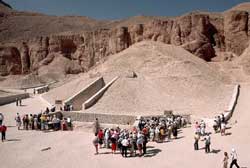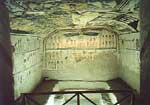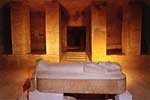|
Valley of the Kings
The king's formal names and titles are inscribed in his tomb
along with his images and statues. Beginning with the 18th
Dynasty and ending with the 20th , the kings abandoned the
Memphis area and built their tombs in Thebes. Also abandoned
were the pyramid style tombs.
Most of the tombs were cut into the limestone following a
similar pattern:
 three corridors, an antechamber and a sunken sarcophagus
chamber. three corridors, an antechamber and a sunken sarcophagus
chamber.
These catacombs were harder to rob and were more easily
concealed.
Construction usually lasted six years, beginning with the new
reign.
The text in the tombs are from the Book of the Dead, the Book of
the Gates and the Book of the Underworld.
The Valley contains 62 tombs to-date, excavated by the
Egyptologists and archaeologists from many countries. Not all of
the tombs belonged to the king and royal family.
Some tombs belonged to privileged nobles and were usually
undecorated.
Not all the tombs were discovered intact, and some were never
completed.
With the increasing tourism, urban and industrial growth,
pollution, and rising groundwater, the tombs have suffered over
the decades.
Today their access is rotated, so that a smaller number of tombs
are open at one time, and even then, many of the decorations and
walls can only be seen behind glass.
Examples
of the most important and preserved tombs:
Ramesses
IV:
Three white corridors descend to the sarcophagus chamber in this
tomb. The chambers ceilings depict the goddess Nut. The lid of
the pink granite sarcophagus is decorated with Isis and Nephthys,
which were meant to serve as guardians over the body. Their
duties fell short, however, as the tomb was robbed in ancient
times. Originally the priests placed the sarcophagus in
Amenhotep II's tomb in order to hide the body, which was a
common practice
 Ramesses
IX: Ramesses
IX:
Two sets of steps lead down to the tomb door that is decorated
with the Pharaoh worshipping the solar disc. Isis and Nephthys
stand behind him on either side. Three corridors lead into an
antechamber that opens into a pillared hall. The passage beyond
that leads to the sarcophagus chamber.
 Merneptah: Merneptah:
The steep descent into the tomb is typical of the designs of the
XIX Dynasty. The entrance is decorated with Isis and Nephthys
worshipping the solar disc. Text from the Book of the Gates line
the corridors. The outer granite lid of the sarcophagus is
located in the antechamber, while the lid of the inner
sarcophagus is located down more steps in the pillared hall.
Carved on the pink granite lid is the figure of Merneptah as
Osiris.
Ramesses
VI:
 Originally built for Ramesses V this tomb has three chambers and
a 4th pillared chamber was added by Ramesses VI. Complete texts
of the Book of the Gates, the Book of Caverns and the Book of
Day and Night line the chambers. Portions of the Book of the
Dead are located in the pillared chamber, along with scenes of
the sky goddess, Nut. Originally built for Ramesses V this tomb has three chambers and
a 4th pillared chamber was added by Ramesses VI. Complete texts
of the Book of the Gates, the Book of Caverns and the Book of
Day and Night line the chambers. Portions of the Book of the
Dead are located in the pillared chamber, along with scenes of
the sky goddess, Nut.
 Ramesses
III: Ramesses
III:
The tomb is sometimes referred to as the "Harpers Tomb" due to
the two harpers playing to the gods in four of the chambers. Ten
small chambers branch off of the main corridors. These were for
the placement of tomb furniture.
Seti I:
 The longest tomb in the valley, 100m, contains very well
preserved reliefs in all of its eleven chambers and side rooms.
One of the back chambers is decorated with the Ritual of the
Opening of the Mouth, which stated that the mummy's eating and
drinking organs were properly functioning. Believing in the need
for these functions in the afterlife, this was a very important
ritual. The sarcophagus is now in the Sir John Soane Museum,
London. The longest tomb in the valley, 100m, contains very well
preserved reliefs in all of its eleven chambers and side rooms.
One of the back chambers is decorated with the Ritual of the
Opening of the Mouth, which stated that the mummy's eating and
drinking organs were properly functioning. Believing in the need
for these functions in the afterlife, this was a very important
ritual. The sarcophagus is now in the Sir John Soane Museum,
London.
 Tuthmosis
III: Tuthmosis
III:
The approach to this unusual tomb is an ascent up wooden steps,
crossing over a pit, and then a steep descent down into the
tomb. The pit was probably dug as a deterrent to tomb robbers.
Two small chambers, decorated with stars, and a larger vestibule
are in front of the sarcophagus chamber, which is uniquely
rounded and decorated with only red and black.
Amenhotep
II :
In this Tomb, a steep flight of stairs and a long unadorned
corridor lead to the sarcophagus chamber. Three mummies,
Tuthmosis IV, Amenhotep II III and Seti II, were found in one
side room and nine mummies were found in another.
Tutankhamun:
Though small and unimpressive, Tutankhamun's Tomb is probably
the most famous, due to its late discovery. It was opened 1922
and the royal seal on the door was found intact. The first three
chambers were unadorned, with evidence of early entrance through
one of the outside walls. The next chamber contained most of the
funerary objects. The sarcophagus was four guilded wooden
shrines, one inside the other, within which lay the stone
sarcophagus, three mummiform coffins, the inner one being solid
gold, and then the mummy. Haste can be seen in the reliefs and
the sarcophagus, due to the fact that Tutankhamun died at only
19 years of age following a brief reign. Though extremely
impressive to the modern world, the treasures of Tutankhamun
must have paled when compared to the tombs of the great Pharaohs
that ruled for many years during Egypt's golden age. |